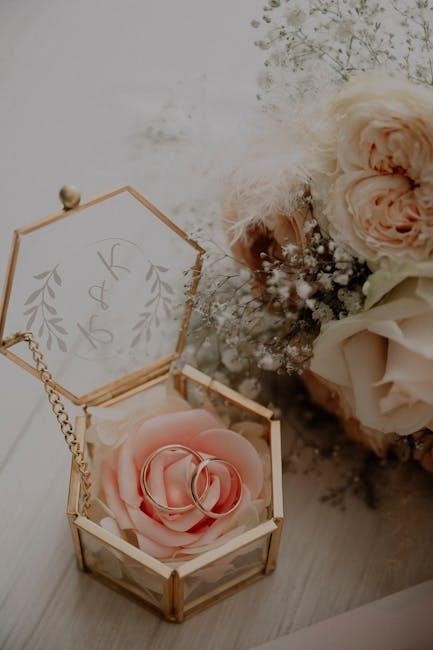Discover the joy of creating personalized keepsake boxes with detailed PDF plans. These guides offer step-by-step instructions, from cutting wood to adding decorative finishes, perfect for craftsmakers. Use these plans to craft meaningful storage solutions with ease, ensuring durability and aesthetic appeal for cherished belongings. Ideal for woodworking enthusiasts, these PDF resources provide creative and practical designs for all skill levels. They include material lists, tool recommendations, and tips for achieving professional results. Whether for gifts or personal use, these plans inspire creativity and precision in every project. Start your woodworking journey with these comprehensive keepsake box plans today. Perfect for storing jewelry, mementos, and more!
Overview of Keepsake Boxes and Their Importance
Keepsake boxes are cherished containers for storing precious memories, jewelry, and mementos, blending practicality with sentimental value. They serve as meaningful gifts or heirlooms, preserving emotions and stories. Crafted from various materials, these boxes offer a personalized way to organize and protect treasured items. Their importance lies in their ability to hold memories while providing a beautiful display. Woodworking enthusiasts appreciate the creative process, resulting in a unique, functional piece that transcends time, making them invaluable for generations to come.
Why Choose PDF Plans for Your Keepsake Box Project
PDF plans offer convenience, clarity, and accessibility for your keepsake box project. They provide detailed instructions, measurements, and diagrams in a digital format, easily downloadable and viewable on various devices. PDFs ensure consistency and accuracy, reducing errors and saving time. They are cost-effective, with many free options available, and sharable for collaborative projects. Plus, they are environmentally friendly, eliminating the need for physical copies unless desired. PDF plans are a practical choice for both novice and experienced craftsmakers, enhancing the woodworking experience with precision and ease.

Materials and Tools Required
Essential tools include a table saw, router, and clamps, while materials like 5/8-inch wood stock, glue, and sandpaper ensure durability and a polished finish for your keepsake box.
Essential Woodworking Tools for Keepsake Box Construction
A table saw is crucial for precise cuts, while a plunge router adds decorative edges and joints. Sandpaper and orbital sanders ensure smooth surfaces. Clamps and a strap clamp help maintain alignment during assembly. A tape measure, square, and marking gauge are vital for accurate measurements. Safety gear, like safety glasses, protects during cutting and routing. These tools ensure your keepsake box is crafted with precision and care, resulting in a durable and visually appealing storage solution for cherished items.
Recommended Materials for a Durable and Aesthetic Finish
For a keepsake box, use 5/8″-thick wood for sides and 3/8″ for the bottom. Hardwoods like cherry or walnut offer durability and a polished look. Apply a finish with linseed oil or polyurethane to protect the wood and enhance its beauty. Properly sealed wood ensures longevity, especially for storing delicate items. These materials provide a balance of strength and elegance, making your keepsake box both functional and visually appealing for years to come.

Construction Steps for a Keepsake Box
Cut and prepare the sides, assemble using wood glue and clamps, add decorative splines, and secure the lid. Sand and finish for a polished look.
Cutting and Preparing the Sides of the Box
Cut the sides of the box from 5/8″ material using a table saw. Ensure a continuous grain pattern by cutting one short side, then a long side, and repeating. Use a dado stack or multiple passes with a standard blade to create 3/8″ wide by 1/4″ deep dados, positioned 1″ from the bottom. Measure carefully to avoid offset issues. After cutting, sand the edges and clamp the pieces to ensure proper alignment and fit before moving to assembly. This step ensures a sturdy and visually appealing box structure.
Assembling the Box Using Wood Glue and Clamps
Apply wood glue to the edges of the box sides and assemble them in sequence. Use clamps to hold the pieces firmly in place while the glue dries. Ensure the bottom fits snugly but remains free-floating to accommodate wood expansion. Secure the final side with a strap clamp, tightening evenly to maintain squareness. Allow the glue to dry completely before proceeding to ensure a sturdy and precise fit. This step is crucial for achieving a professional-looking keepsake box with proper alignment and durability.
Creating a Decorative Lid with Precision Cuts
Start by cutting the lid to match the box dimensions using a table saw. Achieve a polished look by bevelling the edges with a 20-degree angle cut. For decorative touches, use a router to create intricate profiles or splines. Ensure precise cuts by employing a jig or guide to maintain consistency. Sand the lid thoroughly for a smooth finish. Attach hinges or a friction-fit mechanism for secure closure. These steps will enhance both the functionality and aesthetic appeal of your keepsake box, making it a treasured piece.
Design Considerations
Choose a style that reflects personal taste, from modern to traditional. Consider grain direction for a cohesive look and ensure proportions suit the intended use. Add engravings or intricate cuts for a personalized touch, enhancing both functionality and visual appeal while maintaining durability.
Choosing the Right Style for Your Keepsake Box
Selecting the perfect style for your keepsake box ensures it complements its intended use and personal aesthetic. Consider modern, rustic, or traditional designs, each offering unique charm. A Craftsman-style box features clean lines and minimal ornamentation, while a rustic design emphasizes natural wood textures. For elegance, opt for intricate lid details or decorative cuts. Personalize the box with engravings or color schemes to match its purpose. Ensure the style aligns with the grain direction for a cohesive look. Choose a design that reflects the keepsakes it will hold, making it a timeless treasure.
Adding Personalized Details and Engravings
Personalized details and engravings elevate your keepsake box, making it truly unique. Use a plunge router to create decorative insets or add engravings with a router bit for intricate designs. Consider engraving names, dates, or meaningful quotes to commemorate special occasions. For a polished finish, sand the engravings smooth and apply a wood finish. These personal touches transform the box into a heartfelt gift or heirloom, ensuring it holds emotional value. Explore various patterns and fonts to match the box’s style and the recipient’s preferences, creating a one-of-a-kind treasure.
Finishing Touches
Sanding ensures a polished look, while applying wood finish enhances durability and aesthetics. Add hardware like hinges for secure closure, completing your keepsake box with professional flair.
Sanding and Applying Wood Finish for a Polished Look
Sanding is crucial for achieving a smooth surface. Start with coarse-grit sandpaper, progressively switching to finer grits for a polished finish. After sanding, apply a wood finish like linseed oil or wax to enhance the grain and protect the wood. Multiple thin coats ensure an even, professional appearance. Proper drying between coats is essential. This step transforms the keepsake box into a beautiful, durable storage solution for cherished items.
Adding Hardware for Secure Closure
For a secure closure, install hinges and a latch or small lock. Attach hinges to the back edge of the lid and base, ensuring proper alignment. Use screws to fasten them firmly. Add a latch or magnetic catch to keep the lid closed. Test the closure for smooth operation. For added security, consider a lock. This step ensures your keepsake box is both functional and protected, maintaining its contents safely inside. Proper hardware installation enhances durability and usability.

Free Keepsake Box Plans PDF Resources
Access free keepsake box plans PDFs from top woodworking sites. Download designs for various styles and skill levels, perfect for crafting personalized storage solutions easily.
Top Websites Offering Free Downloadable Plans
Discover top websites offering free downloadable keepsake box plans. Sites like Family Handyman, WOOD Magazine, and Famous Artisan provide detailed PDF guides for various box designs. These resources include step-by-step instructions, material lists, and tips for crafting durable and visually appealing keepsake boxes. Perfect for DIY enthusiasts, these plans cater to all skill levels, from beginners to advanced woodworkers. Download free plans for jewelry boxes, decorative storage solutions, and personalized gift ideas to inspire your next woodworking project.
How to Utilize PDF Plans for a Successful Project
To ensure success, start by thoroughly understanding the PDF plan. Gather all required tools and materials beforehand, ensuring accuracy in measurements. Follow the step-by-step instructions carefully, starting with cutting the sides and bottoms. Use clamps and wood glue for secure assembly, and consider adding decorative elements like splines. Sand thoroughly before applying a finish. Always prioritize safety, wearing protective gear and keeping workspaces organized. By following these steps, you’ll achieve a polished, professional-looking keepsake box.
Safety Tips and Tricks
Always wear protective gear, including safety glasses and gloves. Ensure proper tool usage and maintain a clean workspace. Double-check measurements to avoid errors and injuries.
Essential Safety Precautions in Woodworking
Always wear safety glasses, gloves, and a dust mask when working with power tools. Keep tools sharp and well-maintained to prevent accidents. Ensure your workspace is clean and well-lit. Avoid loose clothing that could get caught in machinery. Use push sticks or splitters when cutting wood to maintain control. Never reach over a moving blade or bit. Keep a first aid kit nearby and emergency contacts accessible. Properly store tools and materials to avoid tripping hazards. Follow manufacturer guidelines for tool usage and safety features.
Common Mistakes to Avoid During Construction
Avoid inaccurate measurements and misalignment during cutting and assembly. Ensure proper clamping to prevent glue squeeze-out and uneven joints. Don’t overlook wood movement—leave space for expansion. Avoid using dull tools, as they can cause splintering or unsafe conditions. Prevent rushed assembly by following plans carefully. Double-check all cuts before proceeding. Keep the workspace organized to avoid errors. Addressing these common mistakes ensures a professional finish and long-lasting keepsake box. Attention to detail is key for a successful project.
Troubleshooting Common Issues
Troubleshoot common issues like uneven joints and lid misalignment. Adjustments may require precise measurements and minor cuts. Addressing these ensures a sturdy and perfectly functional keepsake box easily.
Fixing Uneven Joints and Gaps
Addressing uneven joints and gaps is crucial for a polished keepsake box. Start by identifying the source of the misalignment. Use clamps to hold the pieces firmly in place while checking the fit. If the joint is slightly uneven, sand the edges carefully to even them out. For larger gaps, apply additional wood glue and let it dry before clamping again. Lightly tapping with a mallet can also help align the pieces properly. Once the glue sets, reinforce the joint with small nails or pins for extra stability. Sanding the area afterward ensures a smooth finish, making the repair nearly invisible. Regularly checking the square of the box during assembly helps prevent such issues from arising. Using shims or adjusting the clamping pressure can also aid in achieving a flush fit. Remember, patience is key, as rushing through this process can lead to more significant problems down the line. Properly addressing these imperfections ensures a professional-looking keepsake box that will last for years to come. Always test the fit multiple times before applying glue to avoid costly mistakes. Ensuring even joints not only enhances the appearance but also the functionality of the box, making it a truly treasured item. By meticulously addressing each imperfection, you can create a keepsake box that stands out in both quality and craftsmanship. This attention to detail elevates your project from a simple DIY task to a masterpiece that will be cherished by its recipient.
Adjusting the Fit of the Lid for Perfect Closure
Achieving a precise fit for the lid ensures smooth operation and a professional finish. Start by sanding the edges of both the lid and the box to ensure they are smooth and even. Test the fit frequently, making small adjustments as needed. If the lid feels too tight, lightly sand the edges of the box or lid. For a loose fit, slightly tighten the clamps during assembly to bring the sides closer together. Use fine-grit sandpaper to polish the edges for a seamless closure. Proper alignment is key, so double-check that the lid is centered and even. Avoid forcing the lid into place, as this can damage the joints. Small adjustments can make a significant difference in the overall functionality and appearance of the keepsake box. This step ensures the lid closes securely and evenly, enhancing the box’s durability and aesthetic appeal. Regularly inspecting the fit during assembly helps prevent issues later. By carefully refining the lid’s fit, you create a keepsake box that is both functional and visually appealing. This attention to detail ensures the box will be treasured for years to come.
Creating a keepsake box is a rewarding project that combines craftsmanship with personalization. With detailed PDF plans, you can craft a meaningful storage solution that lasts. Start building today and enjoy the satisfaction of creating something truly special!
Final Thoughts on Building Your Keepsake Box
Creating a keepsake box is a fulfilling project that combines creativity with practicality. With detailed PDF plans, you can craft a beautiful, functional box to treasure memories. Each step, from cutting wood to adding finishes, allows for personal touches. Whether for jewelry, mementos, or gifts, a homemade keepsake box offers lasting value. Embrace the process, enjoy the journey, and take pride in your handmade creation that will be cherished for years to come. Happy building!
Encouragement to Share Your Project and Inspire Others
Sharing your keepsake box project can inspire others to create meaningful pieces. Post your finished box online, detailing your process and materials. This not only showcases your craftsmanship but also encourages others to try woodworking. Feedback and questions from the community can refine your skills and spark new ideas. Be proud of your creation and share it freely—your project could be the motivation someone needs to start their own woodworking journey and create something special.

Affiliate Links and Resources
Explore trusted affiliate links for tools and materials to enhance your keepsake box project. Visit sites like WOOD magazine or Family Handyman for premium plans and resources.
Recommended Tools and Materials for Purchase
For a successful keepsake box project, consider investing in a table saw, plunge router, and dado blade set for precise cuts. A router table and clamp set are also essential for assembly. High-quality materials like 5/8″ thick hardwood ensure durability. Sandpaper, wood glue, and a strap clamp are must-haves for a polished finish. Safety gear, such as gloves and goggles, is crucial. Explore affiliate links for tools and materials tailored to your project needs, ensuring professional results. Shop now and elevate your woodworking experience with trusted resources and products.
